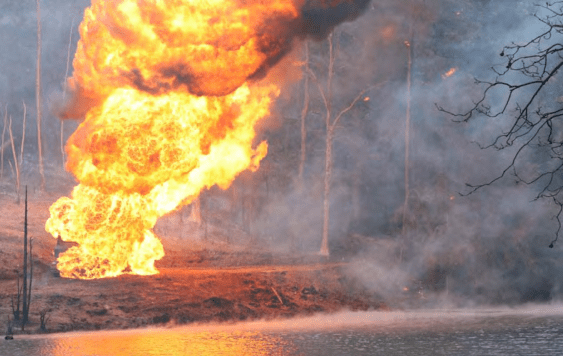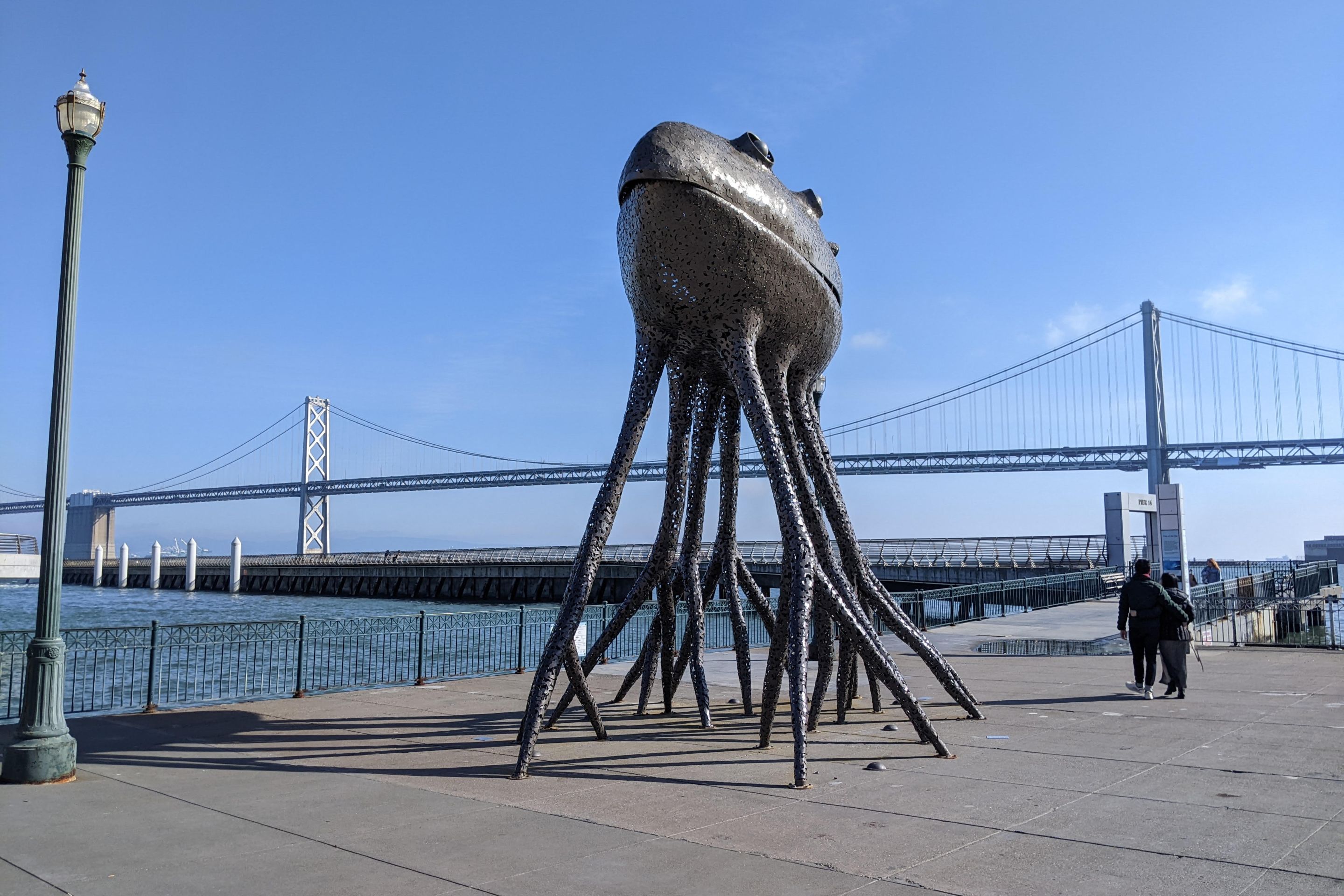 A ghost bike at Masonic and Turk in memory 21-year-old Nils Linke, who was killed by a drunk driver one week ago. Photo: Michael Helquist of BIKE NOPA.
A ghost bike at Masonic and Turk in memory 21-year-old Nils Linke, who was killed by a drunk driver one week ago. Photo: Michael Helquist of BIKE NOPA. A week after a 21-year-old German tourist on a bicycle was killed by a hit-and-run drunk driver on Masonic Avenue, the first death of a bicyclist in the city this year, advocates who have been working for years to calm the major arterial are calling on the SFMTA to make immediate safety improvements.
The SFMTA recently unveiled four long-term options to fix Masonic, but in light of Nils Linke's death Friday night, and with the bike injunction finally lifted, the San Francisco Bicycle Coalition, Michael Helquist of BIKE NOPA and other advocates are urging the agency to take action sooner rather than later.
"We've been really happy and encouraged to see the long-range vision the MTA is putting forward in terms of the four options that have been presented at the community meetings. We think this is really going in the right direction but with the recent tragedy this past weekend we feel like it really underscores the need to make some immediate improvements," said Renée Rivera, the SFBC's acting executive director.
She would like to see buffered bike lanes installed immediately, on a trial basis, in both directions of Masonic Avenue between Ewing Terrace and Fulton Street.
"This section is important because it is a section that is the steepest. Bicyclists are either going fast downhill on that section or going very slowly uphill, so in either case, it would really make the street much safer to put bike lanes with a buffered space between vehicle traffic just on that section. We think that by itself, done immediately, would make a significant improvement on this dangerous street," said Rivera.
For long-term improvements, the Bike Coalition has endorsed Option C in the SFMTA's plans, a street redesign that includes no parking, four traffic lanes and a cycle track.
 A bicyclist rides northbound on Masonic near Turk where Linke was killed. He chooses the sidewalk. Photo: Bryan Goebel.
A bicyclist rides northbound on Masonic near Turk where Linke was killed. He chooses the sidewalk. Photo: Bryan Goebel. Pedaling up or down Masonic, Bike Route 55, can indeed be a risky ordeal because of the wide road and zooming traffic. Jerry Oliver, who works near Geary and Masonic, sometimes opt for the sidewalk, fearing for his safety in the traffic lane.
"Masonic is crazy. It's just nuts. It's a four-lane road and just everybody uses it," said Oliver, who uses the sidewalk on Masonic to get to a calmer side street on his way south to the Panhandle.
"People think it's the autobahn," said Melissa Fernandez, who was
waiting for the 43-Masonic at the Muni stop near Golden Gate Avenue.
"People are going 50 miles an hour when they're supposed to be going god
knows what."
For many bicyclists, Masonic is a main north-south connection, and the
flattest route. On Monday afternoon, I saw plenty of bicyclists
traveling in peak traffic in both directions of Masonic despite the
dangers, and spotted a few on the sidewalk, especially going uphill.
Mariana Parreiras, who lives on nearby Central Avenue and has been involved in the Fix Masonic efforts for three years, said neighborhood activists were disappointed with some of the original designs for improving the street because there weren't enough traffic calming measures in them. Even though the SFMTA lowered the speed limit in 2008 from 30 mph to 25 mph, most drivers ignore it and it's rarely enforced. Lowering down the speed limit is the first bureaucratic hurdle a neighborhood must achieve before the SFMTA can tame a street.
"We knew when we asked for the reduction in speed limit that just that wouldn't have any impact in how people actually behave on the corridor. Changing the sign out from 30 to 25 doesn't make people go any slower but it means that there are more things we can do to it to actually make people move slower," said Parreiras, a transportation engineer.
In a paper last semester on calming Adeline Street in Berkeley for her UC Berkeley city planning class, Parreiras noted how changing an urban street's speed limit to 20 mph, a number that cities such as London and New York have begun implementing in campaigns to make the streets safer for vulnerable users, can make a significant difference.
Many studies show that a small decrease in speed corresponds to a large decrease in both the risk of collision and the severity of injury and risk of fatality of a pedestrian. This suggests that constraining the speed on Adeline to 20 mph instead of 25 mph can have great benefits for pedestrian safety, and by extension, the safety of all other road users.
In addition, she points out the street becomes more inviting to pedestrians and bicyclists, and more people are encouraged to travel by foot and on two wheels.
Advocates in San Francisco would like to see the city explore a 20 mph campaign.
 A majority of the collisions on Masonic Avenue involve cars versus cars. "We know that there are a lot of collisions that happen on Masonic and they are not just with pedestrians or bicycles they're with everybody. We are interested in making it safer for everyone," says neighborhood activist Mariana Parreiras. This photo by Jim Herd shows a March 26, 2008 collision on Masonic near Grove involving three cars.
A majority of the collisions on Masonic Avenue involve cars versus cars. "We know that there are a lot of collisions that happen on Masonic and they are not just with pedestrians or bicycles they're with everybody. We are interested in making it safer for everyone," says neighborhood activist Mariana Parreiras. This photo by Jim Herd shows a March 26, 2008 collision on Masonic near Grove involving three cars. Parreiras said measures such as signal timing on Masonic present challenges because the length of the blocks vary and it's a two-lane arterial (it works easier on a one-way), but she would still like to see the SFMTA investigate it, and the agency appears to be listening.
In response to Linke's death, and the calls by advocates to take quick steps, SFMTA Chief Nat Ford sent a letter (PDF) Thursday to the SFMTA Board of Directors updating them on the agency's efforts to improve Masonic. He recounted everything the agency has done the past few years and said immediate measures will be considered:
The fatal collision has raised questions about what can be done in the immediate short-term to improve conditions on Masonic Avenue. Traffic signal timing will be reviewed with particular emphasis on controlling speeds on vehicles traveling in the southbound, downhill direction of Masonic Avenue. We will also review interim measures that could be implemented in the short-term.
Ford listed a number of changes the SFMTA has made on Masonic, including new pedestrian countdown signals, a new traffic signal on Grove Street at Masonic, the removal of the double left turn lanes from Oak Street onto northbound Masonic, the installation of "YIELD TO PEDESTRIANS AND BIKES" and "BIKES ALLOWED FULL USE OF LANE" signs, upgrades of yellow school crosswalks and signage "to high visibility," and an expansion of the "NO LEFT TURN" peak hour restrictions.
"The SFMTA will continue to work with the community to improve Masonic Avenue," Ford added. He did not respond directly to the SFBC's call for bike lanes to be added immediately.
Even though the SFMTA has made a number of changes over the years, the community is not satisfied with the pace of change or the results.
In 2006, Mark Christianson started the group Fix Masonic to lobby for significant changes. In 2008, he and other neighbors gathered 500 signatures asking the SFMTA to initiate a traffic calming study. That study was delayed for up to a year, according to some advocates, because SFMTA staff was too busy working on the Bike Plan EIR. The SFMTA would not comment directly on why the process has taken so long.
The agency has held two community meetings on Masonic this year, including one earlier this month, and plans another in September or October. The traffic calming study is not expected to be complete until late this year.
"The process from then (2008) to now with a traffic calming process underway is either painfully slow or about right depending on your view of the MTA's response to making traffic design changes," Helquist wrote on his blog, BIKE NOPA. He noted that some of the traffic modifications the SFMTA has suggested in its redesign proposals are "needed now" and "can be implemented without disrupting the eventual design and involve minimal-to-moderate expense."
Reverend Will Scott, an associate pastor and cathedral missioner at St. Cyprian's Episcopal Church on Turk Street, got involved in efforts to fix Masonic about three months ago and agrees there is an urgent need for speed management.
"It's like a freeway in the middle of the city, and I think there are ways that we really need to ask ourselves is speed really a value when there are human lives at stake, and there are many different uses of these streets other than cars," said Scott, who added that he became especially sensitive to the issue after his mother was hit by a driver while walking to a museum in Washington D.C. a few years ago. She is still recovering.
Crossing Turk Street the other day, with food in hand for a potluck, the pastor said he was "terrified." Turk, a wide street that has not been calmed, has a higher speed limit, at 30 mph.
"We need to just be more conscious of just how valuable one another's lives are and the kinds of work around safety both from a long-term ecological perspective but also in the short-term," said Scott. "How do we make sure that we're attentive and aware of one another, and that our city systems recognize that and honor and build streets and roads and buildings that really hold those values and respect those values."
It will now be up to the SFMTA to determine what immediate changes need to be made on Masonic, an issue that will likely be discussed at the SFMTA Board's next meeting September 7th.
“Ultimately, they’re the experts and we expect them to tell us how they’re going to address it. All we want is for the speeds to come down. How exactly they’re going to accomplish that is what they need to tell us," said Perreiras.





